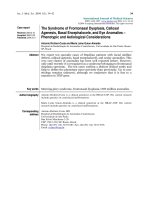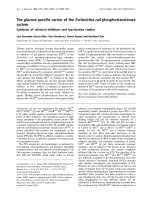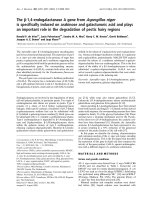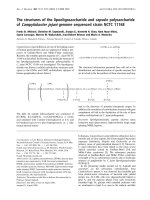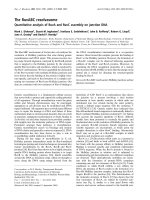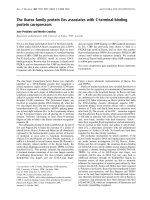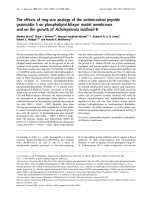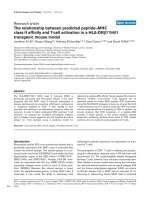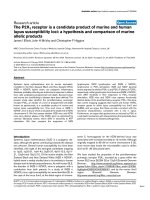Báo cáo y học: " The Simple Triage Scoring System (STSS) successfully predicts mortality and critical care resource utilization in H1N1 pandemic flu: a retrospective analysis" doc
Bạn đang xem bản rút gọn của tài liệu. Xem và tải ngay bản đầy đủ của tài liệu tại đây (523.62 KB, 9 trang )
RESEARCH Open Access
The Simple Triage Scoring System (STSS)
successfully predicts mortality and critical care
resource utilization in H1N1 pandemic flu: a
retrospective analysis
Kayode A Adeniji
*
, Rebecca Cusack
Abstract
Introduction: Triage protocols are only initiated when it is apparent that resource deficits will occur across a broad
geographical area despite efforts to expand or acquire additional capacity. Prior to the pandemic the UK
Department of Health (DOH) recommended the use of a staged triage plan incorporating Sepsis-related Organ
Failure Assessment (SOFA) developed by the Ontario Ministry of Health to assist in the triage of critical care
admissions and discharges during an influenza outbreak in the UK. There are data to suggest that had it been
used in the recent H1N1 pandemic it may have led to inappropriate limitation of therapy if surge capacity had
been overwhelmed.
Methods: We retrospectively reviewed the performance of the Simple Triage Scoring System (STSS) as an indicator
of the utilization of hospital resources in adult patients with confirmed H1N1 admitted to a university teaching
hospital. Our aim was to compare it against the staged initial SOFA score process with regards to mortality, need
for intensive care admission and requirement for mechanical ventilation and assess its validity.
Results: Over an 8 month period, 62 patients with confirmed H1N1 were admitted. Forty (65%) had documented
comorbidities and 27 (44%) had pneumonic changes on their admission CXR. Nineteen (31%) were admitted to
the intensive care unit where 5 (26%) required mechanical ventilation (MV). There were 3 deaths. The STSS group
categorization demonstrated a better discriminating accuracy in predicting critical care resource usage with a
receiver operating characteristic area under the curve (95% confidence interval) for ICU admission of 0.88 (0.78-
0.98) and need for MV of 0.91 (0.83-0.99). This compared to the staged SOFA score of 0.77 (0.65-0.89) and 0.87
(0.72-1.00) respectively. Low mortality rates limited analysi s on survival predictions.
Conclusions: The STSS accurately risk stratified patients in this cohort according to their risk of death and
predicted the likelihood of admission to critical care and the requirement for MV. Its single point in time, accuracy
and easily collected component variables commend it as an alternative reproducible system to facilitate the triage
and treatment of patients in any future influenza pandemic.
Introduction
The word ‘triage’ originates from the French ‘trier’ (to
choose from among several) and was originally applied
around 1792 by Baron Dominique Jean Larrey, surgeon
in chief to Napoleon’s Imperial Guard, as a process of
sorting wounded soldiers. Its aim was to optimize the
use of available medical resources to maximize efficacy
[1]. Patients with the greatest chance of survival with
the least resource use are treated first [2]. In disaster
situations, the focus of medical care i s directed toward
the needs of the community. In this approach, it is clear
that the standard of care for all patients, including those
not directly related to the incident, may need to be
adjusted and reduced. While this may infringe on indivi-
dual rights, the higher ethical principle of ‘wellness of
* Correspondence:
Critical Care Research Unit, SUHT, Southampton General Hospital, Tremona
Road, Southampton, SO16 6YD, UK
Adeniji and Cusack Critical Care 2011, 15:R39
/>© 2011 Adeniji et al.; licensee BioMed Central Ltd. This is an Open Access article distributed under the terms of the Creative Commons
Attribution License ( which permits unrestricted use, distribution, and reproduction in
any medium, provided the original work is properly cited.
society as a whole’ calls for the direction of resources to
those for whom it is felt to be the most effective.
An influenza pandemic had been expected for a num-
ber of years. The resulting preparations led to the need
to examine how different health-care systems around
the world c ould respond to such an event, which may
require a large surge in the need for critical care capa-
city. On 11 June 2009, the World Health Organization
declared the first influenza pandemi c since 1968. Emer-
ging from a triple-reasortant virus circulating in North
American swine [3], the new influenza A virus variant,
H1N1, has affected more than 213 countries and terri-
tories worldwide [4]. Epidemiological models assumed
that the peak demand for critical care resources would
significantly outstrip supply [5]. The pandemic declara-
tion brought into sharp focus the strategic planning that
the international community had been developing since
the outbreak of avian flu H5N1 in 2005 [6]. Surge capa-
city planning identified the need for a consistent and
objective triage system that was based on physiological
scores and that was valid, reproducible, and transparent
given the likelihood of a need to ration critical care
resources [4].
The UK Department of Health (DOH) recommended
a system devised by a panel of experts commissioned by
the Ontario Ministry of Health. This system was pro-
posed to guide ‘critical care resource allocation issues’
during the initial days and weeks of an overwhelming
influenza pandemic and to prioritize admission to criti-
cal care b eds. After an exhaustive literature search, the
Sepsis-related Organ Failure Assessment (SOFA) score
[7] was suggested as part of a staged triage a nd treat-
ment prioritization tool to be used in associ ation with a
number of inclusion and exclusion criteria based upon
comorbidities and estimated prognosis [8,9].
The SOFA score has been shown to reliably evaluate
and quantify the degree of organ dysfunction present on
admission to the intensive care unit (ICU) (initial score)
or developing during ICU stay (delta score equals subse-
quent total maximum SOFA scores minus admission
tot al SOF A). The maximum SOFA score reflects cumu-
lative organ dysfunction that develops and cor relates
with mortality, whereas themeanscoreisagoodprog-
nostic indicator predicting outcome throu ghout an ICU
stay [10,11].
The Ontario Working Group’sproposaltoaidmass
triage had no information on the epidemiology or patho-
physiology of the virus that would cause the pandemic.
The clinical course of H1N1 pandemic influenza has not
occurred as expected. As data has become accessible,
reports suggest that SOFA score may not be a good dis-
criminator of outcome in this cohort of patients [12,13].
Thus, its suitability as a means to assist in the triage of
H1N1 patients has been called into question.
The Simple Triage Scoring System (STSS) (Table 1),
which uses only those vital signs and patient characteris-
tics that are readily available at initial presentation, was
proposed in 2007 by Talmor and colleagues [14] as a
potential alternative tool in predicting death and the uti-
lization of critical care resources during epidemics. Its
components are age, shock index (heart rate > blood
pressure), respiratory rate, oxygen saturation, and
altered mental state. In a multicenter retrospective ana-
lysis of prospectively collected data, the STSS score vari-
ables were validated in two cohorts of patients (n =
1,927) presenting with sepsis to one of two emergency
departments (EDs). The score was found to be predic-
tive of the need for admission to the ICU and the
requirement for mechanical ventilation (MV) and of the
primary outcome of mortality. Our objective was to
review the performance of the admission STSS and
SOFA scoring systems as indicators of the utilization of
hospital resources and of mortality in H1N1 infection
patients admitted to a UK university teaching hospital.
Materials and methods
In a service evaluation assessment, we retrospectively
reviewed the records of all adult patients who were
admitted to the hospital and who were subsequently
confirmed to have contracted H1N1 between July 2009
and February 2010. The study was conducted under the
auspices of the Critical Care Department Research Unit
of the Southampton University Hospital Trust. Pertinent
demographic data, comorbidity, initial chest x-ray (CXR)
findings, mode of ventilatory support, level of care, bed
days, mortality, and the physiological and laboratory
components required to calculate the STSS and SOFA
score s at the point of hospital admissi on were collected.
Where an arterial blood gas result was not available to
calculate the respiratory component of the SOFA score,
the validated oxygen saturation as measured by pulse
oximetry/fraction of inspired o xygen (SpO
2
/FiO
2
)ratio
correlations derived by Pandharipande and colleagues
[15] were u sed. Our institution ’s pandemic flu protocol
called f or the involvement of critical care in any patient
whose FiO
2
requirements exceeded 60% to maintain an
arterial partial pressure of oxygen (PaO
2
) of greater th an
8 kPa. The discriminatory power of the individual score
groupings was calculated and analyzed to assess their
performance in the initial triage of the H1N1 patient
with reference to mortality (primary outcome) and the
need for ICU and need for MV (secondary outcomes).
Statistics
The accuracy of each sc ore in predicting outcome was
assessed by plotting the receiver operating characteristic
(ROC) curve and calculating the area under the ROC
curve (AUC) with 95% confidence inte rvals [16].
Adeniji and Cusack Critical Care 2011, 15:R39
/>Page 2 of 9
The AUC values were ‘ranked’ as excellent (AUC of 0.90
and above), good (AUC of from 0.80 to less than 0.90),
fair (AUC of from 0.70 to less than 0.80), and poor
(AUC of less than 0.70) (SPSS Statistics 19 Inc., Chi-
cago, IL, USA, and IBM, Armonk, NY, USA).
Results
Sixty-two adult patients (35 males) were admitted to our
hospital from either the medical assessment unit or ED
with a polymerase chain reaction-confirmed diagnosis of
H1N1. Their mean age (range) was 41 (18 to 71) years
(Table 2). Forty (65%) had either one (32) or two (8)
comorbidities documented (25 respiratory), three were
morbidly obese, and three were pregnant. Twenty-seven
(44%) had either a secondary bronchopneumonia or
lobar pneumonia reported and formally confirmed by a
consultant radiologist on the admission CXR. Nineteen
(31%) were admitted to the ICU, where three required
only supplementary oxygen, 11 (58%) were managed
with noninvasive ventilation (NIV), and five (26%)
required intubation and MV.
There were three deaths, all with pneumonic features
on their admission CXRs, and two were invasively venti-
lated. Of the two male patients with an STSS score of 2,
one had chronic obstructive pulmonary disease (COPD)
and the other had COPD and biventricular failure. The
latter patient had been treated for H1N1 a week pre-
viously and discharged home and re-presented with a
secondary bacterial chest infection and associated sepsis.
He was still H1N1-positive at this time. He suffered a
myocardial infarction and went into multiple organ fail-
ure. The patient with an STSS score of at least 3 was an
18-year-old female with no comorbidities, presented
after being symptomatic for 5 days with bilateral
bronchopneumonic changes on her CXR, and died from
complications of extracorporeal membrane oxygenation
(ECMO) at the national ECMO center.
The median time from presentation to admission to
the ICU for 16 out of 19 (84%) patients was less than 24
hours (range of 0 to 2 days). Of the three remaining
patients, two were admitted to the ICU after 24 hours
as in-patients and had STSS scores of 2 and SOFA
scores of 3 and 5, respectively. The third patient was
admitted to the ICU 48 hours after hospital admission
and had an STSS score of 2 and a SOFA score of 1; that
patient did not survi ve. The median (ra nge) number s of
level 2 and level 3 critical care bed days used for H1N1
patients over the study period were 4 (2 t o 23) and 23
(1 to 46) days, respectively.
A comparison of the STSS and SOFA score categori-
zation shows a reasonable agreement regarding the
severity of the patients’ illness (Figure 1). The admission
STSS (Table 3) and initial SOFA (Table 4) scores were
calculated and compared against actual mortality, need
for ICU admission, and need for MV. The performance
of STSS and SOFA in our subset is compared with the
figures quoted in the original reports [9,13], in which
the ROC AUC results were used to assess the perfor-
mance of the individual score groupings.
Table 1 The Simple Triage Scoring System
Variable Odds ratio 95%
confidence
interval
Complex rule points Simplified (final) rule points
Respiratory rate >30 breaths per minute 3.9 2.5-6.3 4 1
Shock index >1 (HR > BP) 2.8 1.8-4.2 3 1
Low oxygen saturation 2.8 1.8-4.2 3 1
Altered mental status 1.9 1.3-2.8 2 1
Age of 65 to 74 years 3.0 1.7-5.5 3 1
Age of at least 75 years 4.4 2.7-7.2 4 1
BP, blood pressure; HR, heart rate. Reproduced with the kind permission of Wolters Kluwer Health [14].
Table 2 Clinical characteristics of H1N1 patients admitted
to the hospital
Patient characteristics Ward-based ICU admissions
Number of patients 43 19
Age in years, median (range) 35 (19-71) 53 (18-71)
Sex
Male 26 9
Female 17 10
Comorbidity
12012
235
≥300
Obese 0 3
Pregnant 3 0
Abnormal chest x-ray on admission
Bronchopneumonia 10 9
Lobar pneumonia 4 3
Pulmonary edema 0 1
Mode of ventilation: NIV/MV 0/0 11/5
Hospital outcomes
Bed days, median (range) 4 (0-13) 7 (1-46)
Mortality 0 3
a
a
One patient was transferred from the intensive care unit (ICU) to the ward
for palliation. MV, mechanical ventilation; NIV, noninvasive ventilation.
Adeniji and Cusack Critical Care 2011, 15:R39
/>Page 3 of 9
Owing to the low H1N1-relatedmortalityrateinour
cohort, analysis of this outcome data was not possible.
However, the trends suggest that a higher STSS score
equates with higher mortality in comparison with a high
SOFA score. The SOFA score performed well in pre-
dicting the need for admission to the ICU ( ROC AUC
0.77; 0.65 to 0.89) and the requirement f or MV (ROC
AUC 0.87; 0.72 to 1.00). Nonetheless, the performance
of the STSS score was better at predicting need for ICU
admission (ROC AUC 0.88; 0.78 to 0.98) and need for
MV (0.91; 0.83 to 0.99) (Figure 2).
If the exclusion criteria within the staged triage proto-
colthatincorporatedSOFA(developedbyOntarioand
recommended by the UK DOH) - that is, SOFA score
of greater than 11, chronic lymphocytic leukemia (after
allogenic transplant), lymphoma (after a llogenic trans-
plant), cervical cancer, and cystic fibrosis - had been
applied, a total of five patients would have been
excluded from ICU admission. All of these patients sur-
vived this hospital admission to discharge.
Discussion
During a mass casualty event, the triage of patients to
determine those who may require, do require, and are
receiving definitive critical care interventions needs con-
tinuous re-evaluation to impartially allocate the limited
resources. Once surge capacity has reached its limit, the
delivery of critical care moves to the ‘process of last
0
5
10
15
20
25
012ш3
No. of Patients
STSS Scores
>11
10Ͳ1
1
8Ͳ9
6Ͳ7
4Ͳ5
2Ͳ3
0Ͳ1
SOFA
Scores
Figure 1 Graph comparing the calculated Simple Triage Scoring System (STSS ) with the Sepsis-related Organ Failure Assessment
(SOFA) score patient categories.
Table 3 Discrimination of STSS score groupings in predicting death, ICU admission, and need for mechanical
ventilation in our study population (n = 62) and the derivation population (n = 3,206)
STSS
score
Mortality,
fraction (percentage)
Need for ICU Need for MV,
fraction (percentage)
Derivation
group
a
n = 3,206
Study group
n =62
Derivation
group
a
, fraction
(percentage)
Study group,
fraction
(percentage)
Study bed days, median
(range)
Derivation
group
a
Study
group
0 5/1,144 (0.4) 0/19 (0) 61/1,144 (5.3) 1/19 (5.3) 4 18/1,144 (1.6) 0/19 (0)
1 45/1,257 (3.6) 0/21 (0) 124/1,257 (9.9) 2/21 (9.5) 3 (2-4) 37/1,257 (2.9) 0/21 (0)
2 54/617 (8.8) 2/13 (15.3) 140/617 (23) 7/13 (53.8) 9 (2-46) 43/617 (7) 1/13 (7.7)
≥ 3 47/188 (25) 1/9 (11.1) 68/188 (36) 8/9 (88.8) 8 (3-24) 25/188 (13) 4/9 (44.4)
ROC
AUC
(95% CI)
0.8 Sample too
small
0.7 0.88
(0.78-0.98)
b
- 0.69 0.91
(0.83-0.99)
b
a
Talmor and colleagues [14];
b
Figure 2: Receiver operating characteristic (ROC) curves for Simple Triage Scoring System (STSS) versus intensive care unit (ICU) and
STSS versus mechanical ventilation (MV). AUC, area under the curve; CI, confidence interval.
Adeniji and Cusack Critical Care 2011, 15:R39
/>Page 4 of 9
resort’ (that is, triage) [17]. Ideally, the selected prioriti-
zation tool needs not only to be able to facilitate tertiary
critical care triage (the allocat ion of mechanical ventila-
tors) [18] but also to be applied in the community,
assisting general practitioners in deciding which patients
should be referred t o the hospital and assisting hospital
physicians in deciding whether referral to the ICU is
appropriate [19].
Recently, there has been a great effort to define these
prerequisite basic concepts and assumptions to cope with
critical care resource allocation with many references to
military experience. Standard operating procedures
describing the rationale, components, implementation,
and framework to guide and support the development of
local and national protocols, particularly with regard to
mass infection, have been published [20-22].
A decision matrix in which the weight of objective
prognostic information supersedes any subjective or
individual patient factors may be an uncomfortable
paradigm of deliberation for the physician. Therefore, to
ensure justice both to the physician and to the patient,
there has to be institutional oversight and ‘guidelines’.
A triage plan will equitably provid e every person the
opportunity to survive but cannot guarantee either treat-
ment or survival [8]. However, such a plan cannot
supersede the judgment of a p hysician faced with the
triage situation as it is only upon retrospective analysis
ofthetrueoutcomesofindividualpatientscompared
with their predicted outcomes and triaged status that an
evaluation of the appropriateness and justice of the
triage decision can be made [2].
The SOFA score was origi nally designed to describe
the morbidity ensuing from organ dysfunction in criti-
cally ill patients over the course of their ICU stay. The
maximum SOFA score and the delta SOFA have been
shown to be good instruments in the evaluation and
quantifica tion of the degree of organ dy sfunction/failure
present on admission to the ICU [11]. Ferreira and col-
leagues [10] evaluated the initial, mean, highest, and
delta SOFA scores in a cohort of 352 patients admitted
to their ICU in Belgium. Scores were then correlated
with mortality. The authors showed that an initial SOFA
score of up to 9 predicted a mortality of less than 33%
whereas a score of greater than 11 predicted a mortality
of 95%. When the initial score was 8 to 11, an
unchanged or increasing score was associated with a
mortality rate of 60% (initi al score of 2 to 7 and mortal-
ity of 37%). Therefore, a positive delta SOFA score dur-
ing the first 48 h ours of an ICU admission predicted a
mortality of at least 50%.
The Ontario protocol, as in the military, advocated the
application of a color-coded prioritization tool. Reassess-
ment would occur at specified time periods (approxi-
mately 48 and 120 hours) by a member of the triage
Table 4 Discrimination of initial SOFA score groupings in predicting mortality in our study population (n = 62) and in
the derivation population (n = 352)
Initial
SOFA
Score
Mortality,
fraction (percentage)
Need for ICU Need for MV, fraction
(percentage)
Derivation
group
a
n = 352
Study group
n =62
Study group,
fraction
(percentage)
Study bed days, median
(range)
Study group
0-1 0/43
(0)
1/21
(4.8)
2/21
(9.5)
10.5
(4-17)
0/21
(0)
2-3 5/77
(6.5)
1/25
(4)
9/25
(36)
4
(2-23)
2/25
(8)
4-5 18/89
(20.2)
0/10
(0)
2/10
(20)
15
(8-22)
0/10
(0)
6-7 14/65
(21.5)
1/5
(20)
5/5
(100)
4
(1-46)
2/5
(40)
8-9 11/33
(33.3)
0/0
(0)
0/0
(0)
0 0/0
(0)
10-11 12/24
(50)
0/0
(0)
0/0
(0)
0 0/0
(0)
>11 20/21
(95.2)
0/1
(0)
1/1
(100)
24 1/1
(100)
ROC AUC (95%
CI)
0.79 Sample too
small
0.77 (0.65-0.89)
b
- 0.87 (0.72-1.00)
b
>11 and
exclusion criteria
20/21
(95.2)
0/5
(0)
3/5
(60)
- 2/5
(40)
These data were used to assess whether Sepsis-related Organ Failure Assessment (SOFA) score had some functionality in predicting need for intensive care unit
(ICU) and need for mechanical ventilation (MV) in our study group.
a
Ferreira and colleagues [10];
b
Figure 2: Receiver operating characteristic (ROC) curves for
SOFA versus ICU and SOFA versus MV. AUC, area under the curve; CI, confidence interval.
Adeniji and Cusack Critical Care 2011, 15:R39
/>Page 5 of 9
team. Patients not meeting the inclusion criteria at reas-
sessment or deteriorating and not expected to survive are
transferred to the ward for ongoing care or p alliation,
respectively. This re-evaluation would also be applied to
ward-based patients who deteriorate or improve. The
‘cutoff’ would be the presentation with or development of
a SOFA score of greater than 11 [2,8,19,20,22].
Predictive validity considers the degr ee to which the
triage acuity level pre dicts true acuity. The primary pro-
blem with predictive scoring systems is that they are
population-specific and are derived from and validated
on specific cohor ts of patients and thus their ability to
predict the outcome of an individual is poor [23].
Therefore, the decision to reassign a mechanical ventila-
tor from one patient to another would be difficult to
justify unless a large difference (approximately 25%) [22]
in the survival advantage predicted by the scoring sys-
tem were demonstrated. Critical care scoring systems
have not been designed for this purpose.
In this study, we assessed the performance of an alter-
native scoring system, the STSS, in H1N1 patients
admitted to a UK teaching hospital. We compared this
with the initial SOFA score as the organ dysfunction
measure within a triage prioritization tool. To our
Figure 2 Comparisons of the area under the receiver operating characteristic curves predicting admission to the intensive care unit
and requirement for mechanical ventilation. (A) STSS scores ability to predict the H1N1 patients admission to the ICU. (B) SOFA scores ability
to predict the H1N1 patients admission to the ICU. (C) STSS scores ability to predict the H1N1 patients subsequent need for mechanical
ventilation. (D) SOFA scores ability to predict the H1N1 patients subsequent need for mechanical ventilation. SOFA, Sepsis-related Organ Failure
Assessment; STSS, Simple Triage Scoring System.
Adeniji and Cusack Critical Care 2011, 15:R39
/>Page 6 of 9
knowledge, the performance of STSS has not been
tested on patients during a pandemic. Although the
STSS was developed in a cohort of individuals present-
ing with a variety of infectious diseases to an ED, it was
recommended for use during a pandemic. It is simple
and can be carried out by a wide range of health-c are
staff in a variety of settings. Importantly, the STSS score
excludes both the patient’ s history (which may not be
available at the point of entrance into the medical sys-
tem) and laboratory testing (which adds time delay to
triage). SOFA incorpora tion of the latter would result in
a delay in decision making and consumption of
stretched laboratory resources. Additionally, whereas th e
variability in the subjective assessment of the Glasgow
Coma Scale component in the SOFA may affect its
inter-observer accuracy, the binary nature of the com-
parison measure in the STSS of ‘altered mental state’
may ameliorate this source of error. In our cohort of
patients, STSS performed well, risk-stratifying patients
with this viral illness with regard to the need for admis-
sion to the ICU and need for MV.
The clinical nature of any pandemic becomes apparent
only as the event unfolds. Fortunately, the mortality of
H1N1 has been c onsiderably less than that seen with
H5N1. It is widely reported that t he clinical attack rate
and most severe disease have been highest in the young
[24]. The Australasian and Canadian experiences of the
2009 pandemic demonstrated how population differ-
ences in different communities can confound the appli-
cation of ‘evidence’ across these disparate populations.
Kumar and colleagues [25] reported that 43/168 (25.6%)
of critically ill flu patients in Canada ov er the period
described were Inuit, who represent just 3.75% of the
population. Similarly, the ANZIC (Australian a nd New
Zealand Intensive Care) investigators reported that the
Aboriginals (2.5% of the population) represented 9.7% of
the ICU admissions in Australia and the Maoris (13.6%
of the population) emerged as 25% of the critically ill in
New Zealand [25,26]. The pattern of illness was mark-
edly different in our population. Without a native indi-
genous population that may have lacked exposure to
previous H1N1 epidemics and in the context of freely
available antivirals a nd latterly a specific pandemic vac-
cine, we were fortunate to suffer only three deaths in
our study population. In addition, a large number of our
almost entirely European Caucasian patients benefited
from the application of NIV - this was not seen in either
Canada or Australasia. Our low mortality rate prevented
assessment of the STSS scores’ discriminatory potential
with regard to H1N1.
Although the STSS scale has only 4 po ints (as
opposed to a maximum of 24 on the SOFA scale), the
STSS discriminated between outcomes equally well in
this study, and crude data analysis suggest that it may
be better. The ROC areas for the STSS score which
related to b oth secondary o utcomes of ICU admission
and need for MV demonstrated both higher values and
better fit than the SOFA score values, despite our small
sample size.
Although the Ontario staged triage protocol has not
been evaluated as a predictor of health-care resource
usage, our study suggests that SOFA’s utility in this
respect was fair for ICU admission (AUC 0.77) and
good for MV (AUC 0.87). Part of the Ontario’srecom-
mended remit was to ‘identify at an early stage those
patients not respo nding to treatment and therefore
likely to have a poor outcome once treatment and
care start by formal periodic assessments to determine
whether they are not responding to treatment or are
deteriorating despite treatment, and so further treatment
should be withheld in favor of symptom relief’ [19]. Fer-
reira and colleagues [10] note that length of stay (LOS)
was not related to outcome prediction when using
SOFA and that the mean SOFA score had a better prog-
nostic value than the other SOFA-derived variables; that
is, patients who presented with a limited degree of
organ dysfunction and had a long stay could still have a
high likelihood of survival.
An increase in SOFA score in the first 48 hours is
ass ociated with 53% risk of death and a mean LOS 12.4
days. However, Khan and colleagues [12] showed 6 3%
survival in their SOFA defined poor prognosis group
with H1N1 with a mean LOS of 11 (range of 3 to 17)
days. This presents a problem if we assume that the
DOH intended that the triage tool be applied to limit
those 12.4 days by early palliation. If we also consider
the published risk o f death following delta SOFA reduc-
tion (23%) to the risk of death with delta SOFA increase
(37%) of Khan and colleagues, this significantly narrows
the difference in risk between those who would possibly
die or possibly survive (14%). Hick and colleagues [22]
suggest that this level of difference would not be enough
to confidently reallocate ventilator resources.
The SOFA score was designed for ICU admission, and
the STSS system was designed for hospital admission.
Their use as the organ dysfunction component within a
triage prioritizatio n tool designed for use at all levels of
health-care delivery from community to critical care
obviates any concerns about the difference between sec-
ondary and tertiary triage measures. Eighty-four percent
of the patients were transferred to the ICU less than
24 hours afte r their admission and we would therefore
have expected an equivalent or better performance from
the SOFA score. The three patients who had their
scores calculated at a time distant from their admission
to the ICU had SOFA scores ranging from 1 to 5 and
an STSS score of 2. The pa tient with the SOFA score of
1 was admitted to the ICU after 2 days as an in-patient
Adeniji and Cusack Critical Care 2011, 15:R39
/>Page 7 of 9
but did not survive; he was readmitted to the hospital
with pneumonia after being discharged home (but still
H1N1-positive) and died of multi-organ failure.
We would submit that these factors suggest that the
STSS performs better in this population and overall
would be a more appropriate early-assessment triage
rule. Given the heterogeneity of possible events causing
a mass casualty episode, no single tool can be expected
to provide adequate decision-making power. Owing to
the potential uncertainty arising from each individual
patient’s physiological response to treatment, scoring
systems must be tempered by clinical decision making
and viewed as indicators to assist clinical assessments
and not as definitive triaging values. Owing to the
unpredictable nature of any new strain of a pandemic
virus, many authorities call for continuous revalidation
and refinement o f any triage model and its scoring sys-
tems at the point of outbreak and throughout all of its
phases to thereby determine th eir suitability and discri-
minating power for use as triage prioriti zation tools at a
multicenter/national level [8,18,19].
It is clear that, in the absence of a thoughtful
approach to triage, critical care r esources would be
depleted within the first weeks of a pandemic. Suc h
triage tools will also require a staged approach that
needs to start with the patient in the community and to
triage in a stepwise manner those who ultimately will
require maximum care in a critical care unit. The STSS
score is designed to be used at the front door of the
hospital and may be of value in indicating patients who
will require high resource utilization. In our small
cohort, it a ppeared to perform as well as, if not better
than, the SOFA score in identifying those who needed
ICUcare.Thefocusatthehospitallevelwouldbeon
establishing the process that will be followed at the
health-care facility. This is crucial because, regardless of
the origin of the decision to ol, the implementation of
the tool occurs at the hospital level [22]. Therefore, ade-
quate workforce knowledge and training regarding the
underlying principles of any prioritization tool are
required to overcome the natural reluctance of medical
staff to ‘ration’ their care delivery [27].
Our study is limited by its retrospective nature, size,
and number of significant events. The performance of
STSS scores in ‘all comers ’ to the ED and specifically to
theICUaswellasoverthetimecourseofeachindivi-
dual admission was not assessed, raising concerns about
the validity of these scores in other critically ill patients.
However, it should be remembered that the SOFA scor e
was also initially developed, in 1996, as a sepsis-related
score [7]. What our study highlights is that mandating a
particular scoring system may not be the best approach.
Perhaps considering diff erent tools in the early phase,
including perhaps one employing a disease-specific scor-
ing system, and quickly assessing their utility may be
the most pragmatic approach until the clinical course
and pathophysiology of the particular influenza variant
become apparent.
Conclusions
In summary, it would appear that the four groupings of
the STSS score, despite being underpowered because of
a small sample size, number of deaths, and percentage
of those mechanical ventilated, ‘accurately’ risk-stratify
patients in this cohort according to their risk of death
and predict the likelihood of admission to critical c are
and the requirement for mechanical ventilation in line
with the derivation population. The fact that the STSS
score is measured at a single point in time, its accuracy,
and its easily collected component variabl es commend it
as an alternative reproducible system to facilitate the
triage and treatment of patients in any future influenza
pandemic. Further analysis should include a prospective
evaluation of its validity as a staged protocol in a larger
cohort of unselected unwell patients presenting to the
ED and an assessment of its morbidity and mortality
prediction in different populations once those patients
have been admitted to the ICU.
Key messages
• The Simple Triage Scoring System (STSS) score is
easier to calculate and accurately predicts critical
car e resource us age (admission to the intensive care
unit and requirement for mechanical ventilation) in
H1N1 with initial hospital presentation parameters.
• Further analysis of the STSS score as a predictor of
mortality in this cohort of patients should be
investigated.
• The STSS s core should be considered an alterna-
tive triage tool in future epidemics.
Abbreviations
AUC: area under the curve; COPD: chronic obstructive pulmonary disease;
CXR: chest x-ray; DOH: Department of Health; ECMO: extracorporeal
membrane oxygenation; ED: emergency department; FiO
2
: fraction of
inspired oxygen; ICU: intensive care unit; LOS: length of stay; MV: mechanical
ventilation; NIV: noninvasive ventilation; ROC: receiver operating
characteristic; SOFA: Sepsis-related Organ Failure Assessment; STSS: Simple
Triage Scoring System.
Acknowledgements
The authors would like to acknowledge Kim de Courcy-Golder for her
collection of the data that informed the study and Bernard Higgins for his
contribution to the statistical analysis of our findings.
Authors’ contributions
Both authors participated in the formulation and design of this study,
performed the literature search, and abstracted the data. KAA wrote the first
draft of the manuscript, which was then revised by RC. Both authors read
and approved the final manuscript.
Adeniji and Cusack Critical Care 2011, 15:R39
/>Page 8 of 9
Competing interests
The authors declare that they have no competing interests.
Received: 28 May 2010 Revised: 26 November 2010
Accepted: 26 January 2011 Published: 26 January 2011
References
1. Robertson-Steel I: Evolution of triage systems. Emerg Med J 2006,
23:154-155.
2. Repine TB, Lisagor P, Cohen DJ: The dynamics and ethics of triage:
rationing care in hard times. Mil Med 2005, 170:505-509.
3. Smith GJ, Vijaykrishna D, Bahl J, Lycett SJ, Worobey M, Pybus OG, Ma SK,
Cheung CL, Raghwani J, Bhatt S, Peiris JS, Guan Y, Rambaut A: Origins and
evolutionary genomics of the 2009 swine-origin H1N1 influenza A
epidemic. Nature 2009, 459:1122-1125.
4. World Health Organization: Pandemic (H1N1) 2009 - update 9. [http://
www.who.int/csr/don/2010_03_12/en/index.html].
5. Ercole A, Taylor BL, Rhodes A, Menon DK: Modelling the impact of an
influenza A/H1N1 pandemic on critical care demand from early
pathogenicity data: the case for sentinel reporting. Anaesthesia 2009,
64:937-941.
6. Beigel JH, Farrar J, Han AM, Hayden FG, Hyer R, de Jong MD, Lochindarat S,
Nguyen TK, Nguyen TH, Tran TH, Nicoll A, Touch S, Yuen KY, Writing
Committee of the World Health Organization (WHO) Consultation on
Human Influenza A/H5: Avian influenza A (H5N1) infection in humans. N
Engl J Med 2005, 353:1374-1385.
7. Vincent JL, Moreno R, Takala J, Willatts S, De Mendonça A, Bruining H,
Reinhart CK, Suter PM, Thijs LG: The SOFA (Sepsis-related Organ Failure
Assessment) score to describe organ dysfunction/failure. On behalf of
the Working Group on Sepsis-Related Problems of the European Society
of Intensive Care Medicine. Intensive Care Med 1996, 22:707-710.
8. Christian MD, Hawryluck L, Wax RS, Cook T, Lazar NM, Herridge MS,
Muller MP, Gowans DR, Fortier W, Burkle FM: Development of a triage
protocol for critical care during an influenza pandemic. CMAJ 2006,
175:1377-1381.
9. Christian M, Hamielec C, Lazar N, Wax R, Griffith L, Herridge M, Lee D,
Cook DJ: A retrospective cohort pilot study to evaluate a triage tool for
use in a pandemic. Crit Care 2009, 13:R170.
10. Ferreira FL, Bota DP, Bross A, Melot C, Vincent J: Serial evaluation of the
SOFA score to predict outcome in critically ill patients. JAMA 2001,
286:1754-1758.
11. Moreno R, Vincent JL, Matos R, Mendonça A, Cantraine F, Thijs L, Sprung C,
Antonelli M, Bruining H, Willatts S: The use of maximum SOFA score to
quantify organ dysfunction/failure in intensive care. Results of a
prospective, multicentre study. Working Group on Sepsis related
Problems of the ESICM. Intensive Care Med 1999, 25:686-696.
12. Khan Z, Hulme J, Sherwood N: An assessment of the validity of SOFA
score based triage in H1N1 critically ill patients during an influenza
pandemic. Anaesthesia 2009, 64:1283-1288.
13. Guest T, Tantam G, Donlin N, Tantam K, McMillan H, Tillyard A: An
observational cohort study of triage for critical care provision during
pandemic influenza: ‘clipboard physicians’ or ‘evidenced based
medicine’?
Anaesthesia 2009, 64:1199-1206.
14. Talmor D, Jones AE, Rubinson L, Howell MD, Shapiro NI: Simple triage
scoring system predicting death and the need for critical care resources
for use during epidemics. Crit Care Med 2007, 35:1251-1256.
15. Pandharipande PP, Shintani AK, Hagerman HE, St Jacques PJ, Rice TW,
Sanders NW, Ware LB, Bernard GR, Ely EW: Derivation and validation of
Spo2/Fio2 ratio to impute for Pao2/Fio2 ratio in the respiratory
component of the Sequential Organ Failure Assessment score. Crit Care
Med 2009, 37:1317-1321.
16. Zweig MH, Campbell G: Receiver-operating characteristic (ROC) plots: a
fundamental evaluation tool in clinical medicine. Clin Chem 1993,
39:561-577.
17. Tillyard A: Reorganising the pandemic triage processes to ethically
maximise individuals’ best interests. Intensive Care Med 2010,
36:1966-1971.
18. Challen K, Bentley A, Bright J, Walter D: Clinical review: mass casualty
triage - pandemic influenza and critical care. Crit Care 2007, 11:212-212.
19. Department of Health: Pandemic flu: managing demand and capacity in
health care organisations (surge). [ />Publicationsandstatistics/Publications/PublicationsPolicyAndGuidance/
DH_098769].
20. Christian MD, Joynt GM, Hick JL, Colvin J, Danis M, Sprung CL: Chapter 7.
Critical care triage. Recommendations and standard operating
procedures for intensive care unit and hospital preparations for an
influenza epidemic or mass disaster. Intensive Care Med 2010, 36(Suppl 1):
S55-S64.
21. Sprung CL, Zimmerman JL, Christian MD, Joynt GM, Hick JL, Taylor B,
Richards GA, Sandrock C, Cohen R, Adini B, European Society of Intensive
Care Medicine Task Force for Intensive Care Unit Triage during an Influenza
Epidemic or Mass Disaster: Recommendations for intensive care unit and
hospital preparations for an influenza epidemic or mass disaster:
summary report of the European Society of Intensive Care Medicine’s
Task Force for intensive care unit triage during an influenza epidemic or
mass disaster. Intensive Care Med 2010, 36:428-443.
22. Hick J, Rubinson L, O’Laughlin D, Farmer JC: Clinical review: allocating
ventilators during large-scale disasters - problems, planning, and
process. Crit Care 2007, 11:217.
23. Zygun DA, Laupland KB, Fick GH, Sandham JD, Doig CJ: Limited ability of
SOFA and MOD scores to discriminate outcome: a prospective
evaluation in 1,436 patients. Can J Anaesth 2005, 52:302-308.
24. Writing Committee of the WHO Consultation on Clinical Aspects of
Pandemic (H1N1) 2009 Influenza, Bautista E, Chotpitayasunondh T, Gao Z,
Harper SA, Shaw M, Uyeki TM, Zaki SR, Hayden FG, Hui DS, Kettner JD,
Kumar A, Lim M, Shindo N, Penn C, Nicholson KG: Clinical aspects of
pandemic 2009 influenza A (H1N1) virus infection. N Engl J Med 2010,
362:1708-1719.
25. Kumar A, Zarychanski R, Pinto R, Cook DJ, Marshall J, Lacroix J, Stelfox T,
Bagshaw S, Choong K, Lamontagne F, Turgeon AF, Lapinsky S, Ahern SP,
Smith O, Siddiqui F, Jouvet P, Khwaja K, McIntyre L, Menon K, Hutchison J,
Hornstein D, Joffe A, Lauzier F, Singh J, Karachi T, Wiebe K, Olafson K,
Ramsey C, Sharma S, Dodek P, Meade M,
et al: Critically ill patients with
2009 influenza A(H1N1) infection in Canada. JAMA 2009, 302:1872-1879.
26. ANZIC Influenza Investigators, Webb SA, Pettilä V, Seppelt I, Bellomo R,
Bailey M, Cooper DJ, Cretikos M, Davies AR, Finfer S, Harrigan PW, Hart GK,
Howe B, Iredell JR, McArthur C, Mitchell I, Morrison S, Nichol AD,
Paterson DL, Peake S, Richards B, Stephens D, Turner A, Yung M: Critical
care services and 2009 H1N1 influenza in Australia and New Zealand. N
Engl J Med 2009, 361:1925-1934.
27. Tourtier J, Auroy Y: Triage tools errors. Crit Care Med 2010, 38:1500-1501.
doi:10.1186/cc10001
Cite this article as: Adeniji and Cusack: The Simple Triage Scoring
System (STSS) successfully predicts mortality and critical care resource
utilization in H1N1 pandemic flu: a retrospective analysis. Critical Care
2011 15:R39.
Submit your next manuscript to BioMed Central
and take full advantage of:
• Convenient online submission
• Thorough peer review
• No space constraints or color figure charges
• Immediate publication on acceptance
• Inclusion in PubMed, CAS, Scopus and Google Scholar
• Research which is freely available for redistribution
Submit your manuscript at
www.biomedcentral.com/submit
Adeniji and Cusack Critical Care 2011, 15:R39
/>Page 9 of 9
